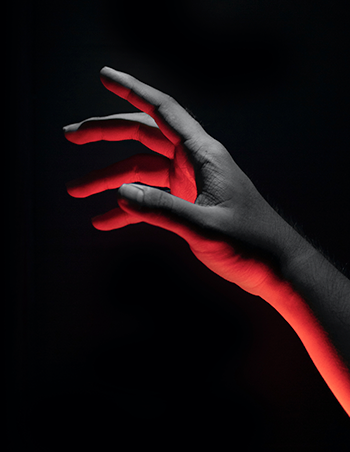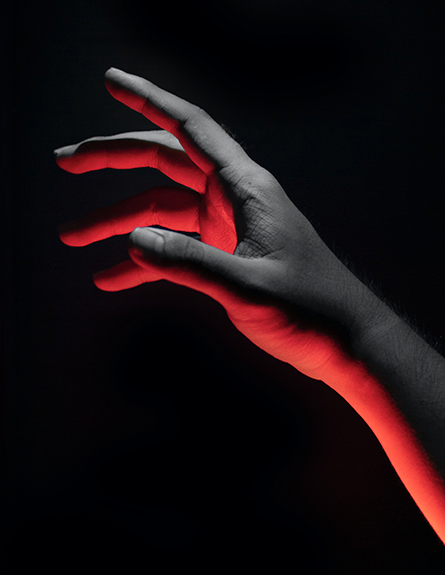
Red Light Therapy: The healing power of light & color
Date: 09/09/2022
Light has a ton of powerful health benefits, but did you know that different colors on the spectrum have different effects on our bodies and mental health? Let’s look at red light therapy (RLT) to see just how therapies involving light can positively influence our day-to-day health.
Above all other things, I love color. Colors have the power to change our moods, brighten an atmosphere, or pull together an otherwise drab scene. Different chakras in our bodies are associated with different colors, while different colored gemstones are meant to have different meanings and properties…so why would light be any different?
That’s the special thing about light though–when concentrated at different wavelengths, light transitions from a ‘white’ beam into all the colors of the rainbow (perceptible to the human eye). Sunlight for example, contains all colors, and when we filter certain rays of natural or artificial light to appear in only one wavelength, we can differentiate the distinct benefits of different light frequencies on our bodies and mental health.
As research has become more pronounced on the subject of light and its benefits, certain light therapies have begun to crop up that have been confirmed to benefit human health. As a longtime consumer of red light therapies, or RLT, I am also well-aware that this type of therapy has been studied more than any other wavelength–though blue light therapies have been known to have some cursory benefits. In the latter case, however, our current over-exposure to blue light through phone and computer screens does seem to warrant us seeking other wavelengths to maintain the right ‘light balance’.
With this in mind, I want to talk about red light therapy today, its benefits, and the types and kinds of at-home red-light therapies I use myself. Together we’ll learn:
- The health benefits of light therapy
- What is red light therapy?
- How does red light therapy work?
- The health benefits of red light therapy
- At-home vs. professional red light therapy options
Remember as you’re reading though: I am not a healthcare professional, but only someone who takes great care with her health, who prioritizes natural healthcare options over chemically-based treatments. I love to research, and work hard to fact-check my work, but still encourage you to check out other articles on the subject or to speak with your healthcare practitioner before you begin any new therapies–though most articles online do say there is little risk to adding red light therapy to your regular health regimen!
The Benefits of Light Therapy | Power of Light
According to recent studies on light exposure in the US, most people don’t get as much natural light as they need for optimal health…since the average American spends over 90% of their time indoors!
This aspect of our daily lives is something I talk about a little bit more in my recent Power of Sun article – where I take a deep dive into the proven advantages of getting a daily dose of natural sunlight (without barriers like sunscreen or sunglasses).
What I wanted to explore a bit more in this article however is the studied benefits of artificial light therapies throughout history. Before I dig into red light therapy (RLT) in particular though, let’s look at the general benefits and history of light therapy as a practice.
A Short History of Light Therapy
Light therapies are NOT new. This type of treatment in fact finds its roots in the medical and physiological health practices of ancient civilizations like Egypt, Greece, and India. As the practice evolved throughout the renaissance period, popular social reformist Florence Nightingale was said to advocate for the use of light to restore health.
Now, this was prior to – and synonymous with – the invention of artificial light, and so it wasn’t until modern light therapies began to take shape almost 50 years later in Scandinavia, America, and Australia that using artificial UV light as a treatment became popular.
The recognized credit for this advance is known to Dr. Niels Finsen, who won a Nobel Prize for medicine when he showed you could use ultraviolet (UV) light to treat tuberculosis…and smallpox scarring with red light.
From there, medical practice involving light therapy has developed into new and exciting practices that are almost too numerous to summarize, with most focusing on the targeted benefits of different types of light on the UV spectrum in treating…
- Cancer, and supporting cancer care
- Depression
- Oral infections
- Eye-sight and retinopathy
- Cardiac surgery complications
- Neurological diseases like parkinson’s disease and MS
If you look back to my Power of Sun article, you’ll also notice that light therapies are in general seen to have major benefits when it comes to mental health, especially Seasonal Affective Disorders popular in the wintertime.
So what is so special about red light therapy?
What is Red Light Therapy (RLT)?
Also called near infrared light therapy, red light therapy is a treatment that exposes the human body to red, artificial LED lights (or lasers). Red light itself is the longest wavelength on the visible light spectrum, and so RLT involves the use of devices that emit red light to target various health conditions.
According to dermatologist Lindsey Zubritsky, red light therapy utilizes these low light wavelengths because this specific wavelength is considered bioactive in human cells, and can directly improve human cellular function. She also reminds us in this article that this particular type of light is not the same as what you get from the sun, and is also not the kind of light you’ll find in tanning beds.
How does Red Light Therapy work?
Here’s a great synopsis of how red light therapy works, without getting too technical:
“Red light therapy is a novel, light-driven treatment that applies low-level lasers or light emitting diodes to deliver red, far-red, or near-infrared light targeting to modulate cellular metabolism and the functioning of a variety of tissues, including the central nervous system and the brain.”
Translation? The red light is applied to your skin externally in pre-specified (safe) concentrations, and penetrates about two to seven centimeters into the skin to create positive reactions within your muscle, nerve, and bone cell photoreceptors.
Once absorbed, cells then receive a huge boost of energy, which supports the production of an energy-amping protein called adenosine triphosphate (ATP). As a result cells repair and regenerate more quickly, and nitric oxide – a gas which helps arteries relax – is released to help with blood regulation.
What’s more, with exposure to red light therapy, this article notes that collagen production is known to increase to provide improved skin structure, while stem cells are also activated in the brain, blood, heart, and bone cells to supercharge tissue healing throughout the body.
According to this article, most therapies rely on red and infrared light ranging from 660 nanometers, to 850 nanometers, with sessions ranging from 15 minutes daily, to an hour of dedicated exposure per week.
What are the benefits of Red Light Therapy?
After even some cursory research on the subject, I can’t help but think it might be easier to write an article about what RLT doesn’t do–because from articles as recent as 2021 and 2022…the potential benefits of red light therapy to human health are infinite!
Click here for a full list of benefits from Carex.
That said, I still want to make the effort to summarize some of the major benefits of red light therapy, whether you use machines at home, or get treatment from a professional. Not only does it reduce symptoms of chronic pain, but it reduces the appearance of acne, improves wound healing, and even supports hair growth!
Let’s see how.
Top 3 Benefits of Red Light Therapy
1. Reduces symptoms of chronic pain and improves wound healing
I have talked a lot about how certain technologies can make the lives of chronic pain patients a little easier in the day-to-day, say with telehealth options right on your smartphone. One of these is through red light therapy, which has been proven to boost cell function and even increase the number of mitochondria in your cells!
When you suffer from chronic pain, a lot of regular pain can become debilitating very quickly, which is why red light therapy is often recommended for chronic pain due to its capacity to reduce pain and inflammation, improve blood flow throughout your body, improve joint function and health, reduce recovery times, and best of all…to enhance your immune system!
Need more? One study from the early 90s showed a 50% reduction in arthritis pain for patients who undergo red light therapy, while a more recent study (though not with human trials) showed RLT to have a significant effect on reducing inflammation in joints for those with arthritis.
2. Reduces appearance of acne, and improves skin health
One of the more popular uses for RLT is to reduce the appearance of acne on the face and skin. RLT is a great drug-free option for those who don’t want to take medication for their acne, or who want to improve the effects they already see with treatment.
Because red light penetrates deep into your skin, it reaches your sebaceous glands, which are responsible for releasing that pore-clogging gunk that causes acne (otherwise known as sebum). The red light thus reduces inflammation in these glands to reduce the appearance of acne.
Just make sure your dermatologist or skin-care professional gives you the go-ahead to pair your treatment with red light therapy, since photodynamic therapy can cause you to be more sensitive to light for as long as three months post-exposure.
Tip: Try using a photosensitizing agent along with your red light therapy for improved effects, such as alpha-lipoic acid…just make sure to consult a professional!
Where regular skin condition is concerned, one 2014 study showed that full-body exposure to red light therapy during 30 sessions (twice a week until complete) increased collagen density for participants–ultimately showing great improvements in wrinkles and skin moisture barrier. It also improves collagen synthesis and increases connective tissues for collagen production.
3. Improves hair growth and regrowth
In 2013, one small study sample revealed that laser light therapy with red light does show a significant improvement to hair counts for men with male-pattern alopecia. With consistent treatment over 16 weeks (every other day), hair counts in previously ‘bald’ areas grew quite a lot!
Men aren’t alone here of course: more recent studies show that RLT-stimulated hair growth (in controlled trials) stimulated the epidermal stem cells in the hair follicle for men and women, to supercharge hair growth!
More Reasons to Try Red Light Therapy
Like I said, there are way more than three reasons to test out red light therapy for yourself as a health practice…here are [ ] more to get your brain on board with the incredible benefits of red light therapy!
(Note: I’ve linked the research related to each article, so feel free to get reading and explore–though some articles are behind paywalls and require journal access to read. Here’s the master list if you’re curious).
- Improvement to spinal cord injuries
- Repairing gingival incisions (wound healing post-surgery for gingivitis)
- Treating oral mucositis
- Treating skin ulcers
- Improving nerve repair
- Treating carpal tunnel syndrome
- Reducing inflammation in light-stressed retinas
- Promoting energy and metabolism
- Cell protection from toxins during other treatments
- Reduce lung damage by excessive oxygen
- Improves memory
- Improves mood disorders
- Reduces stroke related neurodegeneration
With so many benefits, there is no doubt that you’re about ready to try RLT for yourself!
The question is, do you want to engage with a certified professional with high-quality machines? Or do you want to invest in an at-home therapy device that you can take advantage of on your own time?
Take a moment to consider your lifestyle. Do you prefer convenience? Do you have the budget to invest in a red light therapy machine? Do you want to learn from a professional before you try at home?
These are all very important to consider as you begin to use light therapy for your health. So let’s answer the question once and for all: what’s best, at home RLT? Or RLT from a professional?
Can I practice red light therapy at home?
Yes! While you can often get red light therapy treatments in a more professional setting, say as a part of a dermatological procedure or facial treatment, you can still get machines that work in the comfort of your home–though I’ve even noticed that some gyms, spas, and other fitness centers are adopting red light technology to boost healthy cells during high-impact activities. You might be able to find a great option already available at your healthcare or skincare center.
When you go see a professional, there’s a chance that adding the treatment to your regular routine won’t be very costly. A spa I used to frequent offered red light therapy during your post-massage shower for a small $10 fee, though prices can range from there to upwards of $50 per treatment depending. The highest I’ve seen is about $200, so definitely avoid treatments that cost more, but don’t offer additional treatments on top of the RLT.
If you do decide to invest in an at-home device, then know that there are a lot of different device types out there. The most popular are handheld wands, masks, and even full-body panels that allow you to sit or stand nearby and absorb the red light wavelengths.
These types of devices will often range depending on different light characteristics and features. If you want more light energy output, you’ll likely pay higher prices, and if you want more surface area covered with red light, you’ll pay more there too. If you wanted to go wild, you could even invest a couple thousand in purchasing an RLT bed.
It is true that at-home versions may not be as potent as more professional versions, but that’s no reason to think you wouldn’t still get great benefits administering red light therapy yourself, much like you would treat seasonal affective disorder from home with artificial UV lights during the winter months.
My advice? Before you adopt a machine at home, do your homework about different products and brands you can choose from. Read reviews, and like I said before, keep to products that advertise wavelength ranges between the 600 to 850 nanometer range. I also suggest going for at least one professional treatment before you invest in an at-home device, so you know what to expect and can compare should you opt to stick with a professional.
What Red Light Therapy products do you recommend?
With so many products out there, I wanted to make sure to leave you off on the right foot–particularly for those of you who are going to invest in an at-home RLT device.
Again, I would say go to a professional to start with, and discuss your particular symptoms or health concerns to know whether RLT is best to target such symptoms. Then, once you are able to understand the best way to use RLT for your health, you can book more appointments, or start saving for a machine you can use whenever you have a moment.
Then, once you’re ready to start shopping around for an RLT device you’ll love to use, I recommend you start by checking out Biolight, which is an incredible RLT brand I use all the time! This is a proven brand, so prices are a little higher, but you’ll find all kinds of red-light targeting tools…including red light therapies for inside your mouth to promote dental health and inner mouth healing.
If Biolight is a little out of your range, or if you want to compare to another popular company, I think you should check out Joovv, who also sell red light therapy devices and ship almost anywhere! Prices are reasonable, and they also offer a great selection of RLT resources to help customers learn all they can about RLT before they buy. Definitely a trustworthy option with my stamp of approval–I have a Joovv machine myself at home!
With all that said, I just want to underline the importance of getting the right kind (and the right amount) of sun exposure during both the summer and winter months. You want to increase light exposure, yes, but you also want to make sure you’re balancing different types of exposure to maximize all the potential health benefits you can get from light alone.
Again this is the best drug-free way to combat a ton of health issues that crop up on our day to day, and is a great way to continue your health journey as you grow to improve your water intake, food intake, air intake, and more.
Want to learn a few more ways you can improve different aspects of your health without having to alter your entire healthcare or skincare routine? Check out my health and wellness articles at Lena’s World, where you can learn all about water filtration, sunscreen skin care, and much more!
Until next time,
All my love,
![]()
Lena
SUBSCRIBE
Get the latest updates, sneak peeks and more.
 Back To All Posts
Back To All Posts Previous Post
Previous Post

